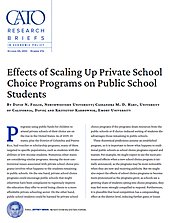Programs using public funds for children to attend private schools of their choice are on the rise in the United States. As of 2019, 25 states, plus the District of Columbia and Puerto Rico, had voucher or scholarship programs, many of them targeted to specific populations, such as students with disabilities or low-income students. Numerous other states are considering similar programs. Among the most controversial issues associated with private school choice programs involves what happens to the students remaining in public schools. On the one hand, private school choice programs could encourage public schools that might otherwise have been complacent to vigorously improve the education they offer to avoid losing clients to a more affordable private schooling sector. On the other hand, public school students could be harmed by private school choice programs if the programs drain resources from the public schools or if choice-induced sorting of students disadvantages those remaining in public schools.
These theoretical predictions assume an established program, so it is important to know what happens to traditional public schools as school choice programs expand and mature. For example, we might expect to see the most pronounced effects when a new school choice program is initially announced, as the programs may be most noticeable when they are new and receiving publicity. But we might also expect the effects of school choice programs to become more pronounced as the programs grow; as schools see a growing share of students opting into choice programs, they may feel more strongly compelled to respond. Furthermore, it is plausible that local competition has a compounding effect at the district level, inducing further gains or losses to public school students’ outcomes. Another important reason why the scale-up of a voucher program may have different effects from those of the introduction of a program is that longer-run scale-up more strongly implies program permanence. It is not uncommon for policies and programs to change dramatically over time, or to be abolished; for instance, Montana’s tax credit scholarship program was in legal limbo for years due to court challenges. Some programs grow in magnitude, while others remain relatively small pilot programs; still others fluctuate wildly in size due to changing legislative appropriations. Only by studying a program’s growth and development over a long stretch of time can we begin to fully understand how voucher programs alter the public school landscape.
Nonetheless, nearly all papers written in the U.S. context—including those written to date by this study’s authors—investigate the introduction of school voucher programs rather than study how the programs affect public schools as they approach some longer-run steady state. The weight of the U.S. evidence shows that the introduction of private school voucher programs has small but positive effects on public school students’ test scores. These studies generally focus on the immediate short-run effects, evaluating the first one to four years after the initial introduction of school voucher programs, when both the pros and cons of the choice program may be constrained due to the small number of initial participants. They do not, however, consider what happens when the private school choice program scales up and the number of students using private school vouchers grows to encompass a sizable fraction of the overall student body. To date, with the exception of a pair of informative but single-market school-level analyses from Milwaukee, Wisconsin, we do not know much about whether scaling up private school choice programs helps or harms public schools. Our research complements this prior work and examines scale-up of a major statewide voucher program—the largest of its kind—over a time frame of more than 15 years, during which the program grew nearly sevenfold from its original size. Finally, our work explores both cognitive and behavioral outcomes, a unique contribution in this literature.
In our work, we leverage extraordinary child-level data that match birth records with school records to evaluate a statewide school voucher program, the Florida Tax Credit Scholarship Program, that grew over the course of about 15 years from much less than 1 percent to roughly 4 percent of the state’s student body participating. In some districts, the participation rate is over 10 percent.
We find evidence that as public schools are more exposed to private school choice, their students experience increasing benefits as the program scales up. In particular, higher levels of private school choice exposure are associated with lower rates of suspensions and absences and with higher standardized test scores in reading and math. These results are not uniform: we find that the public school students most positively affected by increased exposure to private school choice are those of comparatively low socioeconomic status (those with lower family incomes and lower maternal education levels). Nonetheless, we also observe statistically significant but smaller gains for students of higher socioeconomic status who are themselves unlikely to be targeted by the means-tested vouchers. Furthermore, competitive landscapes faced by individual schools and the district are independently important, with those faced by the latter having larger effect sizes on student outcomes. In terms of potential mechanisms, we can rule out explanations related to the composition of students remaining in public schools changing, changes in district-level competition from public school choice options (such as charters or magnets), and the effects of competitive pressures on the resources that public schools have. Thus, in our view, public schools responding to heightened competitive pressure resulting from increased voucher utilization is the most plausible explanation for the estimated gains in test scores and behavior.
Note
This research brief is based on David N. Figlio, Cassandra M. D. Hart, and Krzysztof Karbownik, “Effects of Scaling Up Private School Choice Programs on Public School Students,” Center for Economic Studies CESifo Working Paper no. 9056, May 2021, https://ssrn.com/abstract=3842320.

This work is licensed under a Creative Commons Attribution-NonCommercial-ShareAlike 4.0 International License.



